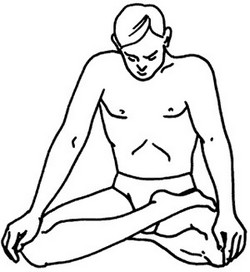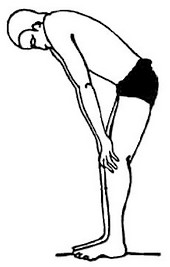Jalandhara bandha is a simple technique, but it is nonetheless very important part of many yoga practices. In Sanskrit jalandhara bandha means “the net of nadis” or ” the net of [energy] pathways”. The word jalan means a “net”, and dhara is a “flow” or “stream”. Jalandhara bandha is a practice or a physical key to control the net or plexus of nadis (the energy pathways or channels in our body). In particular, this bandha controls nadis in the neck. Sometimes these nadis are associated with blood vessels, nerves or pranic channels. The flow or “liquid” that goes through these nadis, can be applied to all these levels of our body (blood, nerves and prana).
There is another definition of jalandhara: in our body there are 16 special centers named adharas. “Adhara” means a “foundation” or “substrate”. This relates to chakras that are situated in the following 16 places in our body: toes, ankles, knees, thighs, perineum, coccyx, navel, heart, neck, tonsils, tongue, nose, brow center, eyes, neck and top of the head. In different practices the consciousness is alternately directed into these centers. Prana flows through these regions as well. Therefore jalandhara can be defined as a practice that locks pranic net in the neck. This prevents prana flowing between these centers and directs it to sushumna nadi or the central energy channel in our body.
The Technique
Take any comfortable meditative pose (asana), that allows you to place your knees on the floor (sukhasana won’t work). If you can’t do any of the asanas, you can either do it while standing, or take the vajrasana pose.
 Place your palms on your knees (or just let them hang if you stand), relax your whole body and close your eyes. Inhale deeply, then hold your breath, and bend your head forward and firmly push the chin to the chest. Straighten your arms, resting them on the knees. Simultaneously lift your shoulders forward and up. Palms must remain on the knees.
Place your palms on your knees (or just let them hang if you stand), relax your whole body and close your eyes. Inhale deeply, then hold your breath, and bend your head forward and firmly push the chin to the chest. Straighten your arms, resting them on the knees. Simultaneously lift your shoulders forward and up. Palms must remain on the knees.
Hold this position for the period of time you can keep your breath without discomfort. Then relax your shoulders and arms. Raise your head slowly and exhale. This will be one cycle.
You can also do this bandha, while holding breath after exhaling (instead of inhaling).
If we are talking about the practice of jalandhara bandha for beginners, then you shouldn’t do more than 10 cycles at a time.
Concentration: on visuddha chakra (throat chakra).
When to Do Jalandhara?
The bandha is usually combined with pranayama, mudras and other bandhas, take mula bandha, for example. If you do it as a separate practice, then it is good after asanas and pranayama, but before the meditation.
Caution: Never inhale or exhale in the final position, when the chin is pressed against your chess.
Jalandhara Bandha Contraindications
It is not recommended for people with high intra-cranial pressure or heart disease unless they do it under the supervision of an experiences yoga teacher.
Jalandhara Bandha Benefits
This chin lock blocks the airways and compresses the various organs, including the sinus receptors located in the larynx. These receptors are sensitive to the pressure of blood in the jugular vein that feeds blood to the brain. When under a high pressure these receptors send signals to the brain, and it slows down the heartbeat. If pressure is low, the work of the heart is activated in a similar way. Thus, the pressure of receptors in the course of jalandhara bandha, slows the heartbeat and calms the mind. In addition, the technique massages the thyroid and parathyroid glands, stimulating them. These glands, especially thyroid, have a wide range of effects on the human body, its growth and sexual function. The practice of jalandhara relieves stress, anxiety and anger. It is also an excellent preparatory exercise for meditation.
The Standing Option
This part is for those who cannot do any of the meditative asanas, and wants to practice jalandhara in a standing position.
 You need to stand erect, keep legs apart at a distance of approximately half a meter. Lean forward, and press your arms against your hip a bit higher above the knees. Inhale deeply (or exhale), hold your breath, and perform the chin lock. To do the lock firmly, straighten your arms. Hold the final position as long as you feel comfortable to, then raise your head, and exhale (or inhale, depending of what you have chosen in the beginning) slowly. After some rest, repeat the bandha. All other details are similar to the sitting variant.
You need to stand erect, keep legs apart at a distance of approximately half a meter. Lean forward, and press your arms against your hip a bit higher above the knees. Inhale deeply (or exhale), hold your breath, and perform the chin lock. To do the lock firmly, straighten your arms. Hold the final position as long as you feel comfortable to, then raise your head, and exhale (or inhale, depending of what you have chosen in the beginning) slowly. After some rest, repeat the bandha. All other details are similar to the sitting variant.
I hope my jalandhara bandha description was clear and easy to follow. If you have some questions, feel free to post them in the comments section below.
